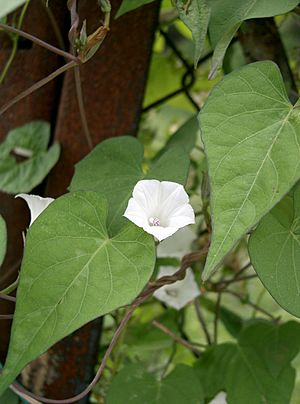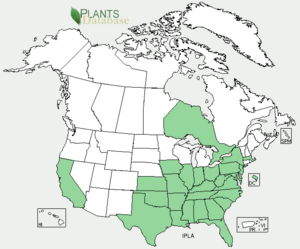Whitestar facts for kids
Quick facts for kids Whitestar |
|
|---|---|
 |
|
| Scientific classification | |
| Genus: |
Ipomoea
|
| Species: |
lacunosa
|
Ipomoea lacunosa, also known as the whitestar, white morning-glory, or pitted morningglory, is a type of plant. It belongs to a group of plants called Ipomoea, and most plants in this group are known as "morning glories". The name Ipomoea comes from Greek words meaning "worm-like," which describes how the plant grows like a twisting vine. Lacunosa is a Latin word meaning "air spaces," referring to the pattern of veins in its leaves.
This plant is originally from the United States and grows every year. Its flowers are usually white and are smaller than the flowers of most other morning glories.
Contents
Where the Whitestar Grows
Since Ipomoea lacunosa is native to the United States, you can find it in many parts of the country. It grows in almost every state on the East Coast. You can also find it in some states in the Midwest and in California.
Some of the states where the whitestar grows include Alabama, Florida, Georgia, Illinois, Indiana, Kansas, Kentucky, Maryland, New York, Ohio, Pennsylvania, Texas, and Virginia. It has also spread to Canada and grows well in Ontario. Even though this plant grows quickly, it usually doesn't spread out of control like some other morning glories.
Where It Lives and What Eats It
Ipomoea lacunosa can live in many different places. It likes disturbed areas, which are places where the ground has been moved or changed. You can find it growing on prairies, along riverbanks and lakeshores, and next to roads. It also grows in fields that are used for farming and fields that have been left alone.
Many insects visit this plant. Bees, like bumblebees, often come to its flowers. The young forms (called larvae) of a type of moth called the plume moth Emmelina monodictyla eat its leaves. It is also a home for several kinds of tortoise beetles.
What the Whitestar Looks Like
The stem of the whitestar is like a twisting vine. It has small white hairs and can climb or twine around other plants. This vine can grow up to 2 meters (about 6.5 feet) long. The plant has small, thin roots that help it stay in the ground.
When the plant is fully grown, its leaves are shaped like a heart, with a pointed tip. Sometimes, the leaves might have three deep sections. Younger plants usually have oval-shaped leaves. The leaves grow one after another along the stem. Each leaf has a thin stalk, called a petiole, which is usually at least 3 centimeters long. The leaves themselves can be up to 8 cm wide and 9.4 cm long. The edges of the leaves are often purple and smooth. The top side of the leaf might have a few white hairs.
Flowers and Fruits
The stalks that hold the flowers are a bit rough and usually have one to three flowers on them. The flowers are shaped like a funnel and are usually white. Sometimes, though, you might see light purple or pink flowers. The five petals of the flower are joined together or have shallow lobes, and they are about 2.5 cm long.
The sepals, which are like small leaves that protect the flower bud, are light green and feel leathery. They can be up to 11.5 mm long. Inside the flower, the anthers (which hold pollen) are pinkish-purple, and the filaments (which support the anthers) are white. The ovary (where seeds develop) is green and shaped like a cone. There is one white stigma and style. The flowers do not have a strong smell.
After the flowers, the plant produces large, round, hairy seed capsules. The seeds inside are irregularly shaped, shiny, and can be brown or black. The fruit is a capsule that is slightly flat or rounded, and it can be up to 10mm wide.
How People Use It
Ipomoea lacunosa is one of the few Ipomoea species that humans use. The whitestar potato, which is a part of this plant, has been traditionally eaten by some Native American tribes, like the Chiricahua Apaches.
Most animals avoid eating Ipomoea plants. This is because they contain chemicals called alkaloids, which can make the plants taste bad or even be harmful. However, some caterpillars can eat and digest these plants without getting sick.


